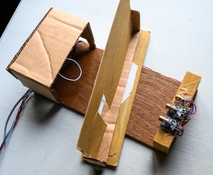Just curious on how your software reacts to capping and other crazy stuff. One unfortunate issue with the "Film Camera Tester" firmware is that if there is capping (the last sensor does not see any light) nothing happens. No warning or error. So, when one is repairing a camera that is really messed up (bounce, capping, slowing too much with the curtain brake, mirror not behaving, etc,) there is no feedback as to what is happening. The device has absolutely no response at all, as if the body cap is on. If you do fiddle with the camera's shutter, and get all the sensors to see light, the first reading (after the 'failed' attempts) is really messed up on the display.
Hi IC, thanks for the question.
Both versions (Arduino & ESP32) will not start a test until both sensors are blocked. This stops the erroneous readings and 'crazy stuff' when placing or removing a camera from the sensor frame. It also makes testing automatic, rather than having to press a 'start' button before every test.
Both versions have a maximum test time of 40 seconds (to allow for slow 32s testing) If the test has not completed during this time, the tester reports the error. This ensures the tester does not hang or have no response.
Similarly tests that are too fast, above 100Ms are reported as errors.
LED flicker interference can be an issue. Both versions now have LED flicker detection. Arduino only reports it during a test, but the more powerful ESP32 has additional detection & reports this in the Setup & Alignment utility.
Both versions detect shutter bounce. As soon as a valid test is seen, the tester just looks at the last sensor for one second and does nothing else. Bounces can be very fast, so full processor time is devoted to this.
Shutter blanking is detected in both versions. Arduino will see it as 'single sensor mode' so only sensor 1 test data will be displayed. The ESP32 version, with three sensors, can report shutter blanking more accurately.
Shutter drag/sticky curtain is now reported on the Arduino version (firmware on Github) It has a generous 1 second of travel time, before reporting as a specific error, but as curtain travel time is displayed, poor blind travel can be seen. The ESP32 version does not directly report shutter drag, instead giving a breakdown of curtain travel speed between each of the three sensors.
All data is validated, to ensure the display is not 'all messed up' failed data is nulled to avoid printing 'crazy stuff'. Only validated data us used to update the averages.
The ESP32 version has a much faster processor and more memory, both flash & ram, so collects and processes more data, from three sensors and the flash socket. This allows even better data validity checks and flash sync reporting.
There is no way (that I can think of) to detect or calibrate shutter braking with a shutter tester. I'm not aware of any tester that can do it. The only way I know of, is the old method of photographing a CRT tube
As you can see from the above, I have done everything I can possibly think of to make the tester function & work properly, without crazy stuff or hanging for no apparent reason. Always happy for feedback, ideas & suggestions for changes & improvements.
Here is a link, detailing single sensor testers and how awful they are. It also details the issue of sensor charatoristics influincing tests. My tester, of course, takes all of this into account to give proper accurate results.
They have another document with more in depth discussion of shutter testers, with sillyscope prints of these silly audio ones, showing how useless they are and also detailing better designed ones, but I am unable to find it at present.
By Oleg Khalyavin Lately, shutter testers are becoming very popular for using on old classic films cameras. Such popularity resulted from the recent availability smartphones, that allow the develop…

kosmofoto.com
 )
) )
)






